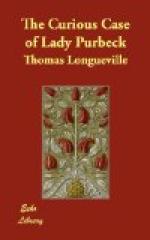In May, 1619, Lady Elizabeth was informed that, if she would give that isle, no longer an island, the Isle of Purbeck, which was her property, to her son-in-law, she should be made Countess of Purbeck and he Viscount Purbeck; but she refused to exchange good land for an empty name. However, in July, Sir John Villiers was created Baron Villiers of Stoke (Stoke Pogis) and Viscount Purbeck. This heaping up of peerages in the Villiers family, in addition to the number of valuable posts, and especially high ecclesiastical posts, obtained by Buckingham for his friends, or for anybody who would bribe him heavily enough to obtain them, led to much murmuring and ill-feeling among those whom he did not thus favour, and greatly irritated the populace. There was no apparent reason why Sir John Villiers should be ennobled, and his peerages were looked upon as a glaring piece of jobbery.
The Court also, at this time, was becoming unpopular. Buckingham was filling it with licentious gallants and with ladies of a type to match them. At Whitehall, there was a constant round of dissipation and libertinism. Besides the very free and easy balls, masques and banquets, there were what were called “quaint conceits” of more than doubtful decency, and there was much buffoonery of a very low type. In the Secret History of the Court of James I. it is recorded that, at this time, namely, about 1618 or 1619, there were “none great with Buckingham but bawds and parasites, and such as humoured him in his unchaste pleasures; so that since his first being a pretty, harmless, affable gentleman, he grew insolent, cruel, and a monster not to be endured.”
Lord Purbeck held the appointment of Master of the Robes to Prince Charles, and he seems to have lived in the palace of the Prince; for, even as late as 1625, we read of Lady Purbeck remaining in “the Prinses house."[45] In 1620 Chamberlain wrote to Carleton[46] that when Buckingham was overpressed by business, he handed over suitors to his brother Purbeck. On the 18th of January, 1620, a letter[47] of Nethersole’s states that Purbeck had resigned his post of Master of the Robes, in order to become Master of the Horse to the Prince.
At some date between that of his marriage in the year 1617 and 1622, Purbeck was received into the Catholic Church, by Father Percy, alias Fisher, a Jesuit. This step does not appear in any way to have affected his position at Court. In a manuscript in the library of the large Jesuit College of Stonyhurst,[48] in Lancashire, it is stated that “the Viscount de Purbeck (sic) brother of the Marquis of Buckingham, having been converted to the Catholic faith and reconciled to the Holy Church, by Father John Persens, S.J., betook himself to the Countess, his mother, and gave her so good an account of the said Father, and of the consolation he had received of him, that she greatly desired to speak to him, and sending him to call the Father, she heard him discourse fully of the Catholic faith, &c.”




